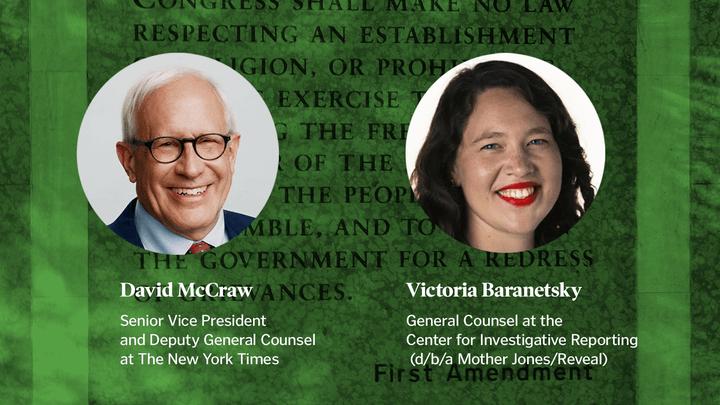Washington Post sued by family of high school student
He was the high school kid at the center of a controversy last month when he stood face-to-face with a Native American elder in a video that went viral. On Tuesday, he was back in the news and, again at the center of a controversy.
Attorneys representing Nicholas Sandmann are suing the Washington Post, seeking $250 million in damages for how the Post covered the story. So why sue the Post when dozens of news outlets covered the story? It’s all about President Donald Trump.
The suit, which was filed by Sandmann’s parents, alleges the Post “targeted and bullied” the 16-year-old student from Covington Catholic High School in Kentucky to embarrass Trump.
The law firm added, “This is only the beginning,” which you could speculate means the Post won’t be the only media outlet sued.
It all stems from the Jan. 19 incident when Sandmann, wearing a “Make America Great Hat,” stood across from Nathan Phillips, a Native American activist who was chanting, near the National Mall in Washington, D.C. The result was several days of heated debate across the country about who was to blame and the various political ramifications. Attorneys for Sandmann feel their client was unfairly treated by the Post.
The complaint states:
“In a span of three days in January of this year commencing on January 19, the Post engaged in a modern-day form of McCarthyism by competing with CNN and NBC, among others, to claim leadership of a mainstream and social media mob of bullies which attacked, vilified, and threatened Nicholas Sandmann, an innocent secondary school child.”
There’s more. In the crux of its argument, the suit added:
“The Post ignored basic journalist standards because it wanted to advance its well-known and easily documented, biased agenda against President Donald J. Trump by impugning individuals perceived to be supporters of the President.”
The Washington Post points out that what the suit is asking for— $250 million — is what owner Jeff Bezos paid to buy the paper in 2013.
Post spokesperson Kristine Coratti Kelly told the Post, “We are reviewing a copy of the lawsuit, and we plan to mount a vigorous defense.”
The man behind one of history’s most famous photos
“The Kissing Sailor.” It’s one of the most famous photographs ever.
It was taken Aug. 14, 1945, better known as V-J Day, the day Japan officially surrendered to the United States in World War II. It was published in Life magazine and became the iconic photo that represented the celebration and relief that the war was coming to an end.
That photo is back in the news this week. George Mendonsa, the sailor in the famous shot, died Sunday just two days short of his 96th birthday. Lot of news organizations did a story about it, but far too many didn’t include this name: Alfred Eisenstaedt. He’s the man who took the photo.
Mickey H. Osterreicher, general counsel for the National Press Photographers Association, wrote Poynter to make sure Eisenstaedt, who died in 1995 at 96, gets the credit he deserves.
Osterreicher, who is married to Buffalo News photo director Cathaleen Curtiss, wrote:
“Maybe we are all being a bit too sensitive but during a time when photography is being so devalued because of the millions of images being uploaded every day and the fact that those who infringe with impunity are emboldened to question the copyrightability of many visual images when caught, it is very disheartening that this image which is synonymous with Eisenstaedt’s name could go unmentioned and uncredited. Would anyone comment on the Mona Lisa without mentioning da Vinci? We think not.”
So here’s to that iconic photo, and the man who took it.
Poynter’s next step in ethics
Poynter recently received $5 million from Craig Newmark Philanthropies to establish the Craig Newmark Center for Ethics and Leadership. So what is Poynter going to do with that $5 million? Poynter’s Kelly McBride, who will head up the center, explains.
Polk winners announced
The George Polk Awards, handed out annually by Long Island University to honor excellence in print, digital and broadcast journalism, were announced Tuesday.
Reporters won in 16 categories. Notable winners included the New York Times for its investigation of Facebook, another Times piece on President Donald Trump’s finances and Wa Lone and Kyaw Soe Oo of Reuters for uncovering how paramilitary police executed 10 Rohingya Muslims.
A couple of other interesting winners:
The award for medical reporting went to a documentary that aired on Netflix. “The Bleeding Edge” looked into the failure of risk-prone medical devices that were introduced without clinical trials and implanted by physicians who might have lacked appropriate training for the surgical procedures involved.
Also, a podcast was honored for the first time as reporter Madeleine Baran and senior producer Samara Freemark won for “In the Dark: Season Two,” about Mississippi death-row inmate Curtis Flowers.
A 12-letter word for smart marketing
That would be the N-E-W Y-O-R-K T-I-M-E-S. Yes, the Times continues to be ahead of the curve in marketing and extending its brand. Certainly, we’re talking about one of the top news outlets in the world, but its most recognizable brand might not be news. It could be the New York Times Crossword Puzzle. Even the name is special, right?
Starting Tuesday, the Times unveiled its first out-of-home marketing campaign for the crossword puzzle with an advertising blitz in Boston and Seattle. The campaign to sign up for the Times Crossword app, as well as other puzzles and games, is aimed at those cities’ commuters with billboards at train and bus stations, as well as inside the trains and buses. The campaign will run through the end of March.
More Times news: The Times and California State Library announced Tuesday that all of the nearly 1,200 public libraries in the state will offer free NYTimes.com access.
Controversial editorial has consequences
In 2007, Goodloe Sutton was inducted into the University of Southern Mississippi’s School of Communication Hall of Fame. On Tuesday, he was booted out. The move comes after Sutton, the publisher of the Democrat-Reporter in Linden, Alabama, wrote a Feb. 14 editorial calling for the “Ku Klux Klan to night ride again” to “clean out D.C.” He also said the KKK really wasn’t that violent and “they didn’t kill but a few people. The Klan wasn’t violent until they needed to be.”
According to the Montgomery (Alabama) Advertiser, Sutton inherited the paper from his father and has worked there since 1964.
Duke vs. UNC
Is there a bigger rivalry than Duke vs. North Carolina? Two of college basketball’s most esteemed programs will meet for the first time this season tonight, and the school news outlets are getting in on the rivalry. Duke’s The Chronicle and UNC’s The Daily Tar Heel are joining forces for a special Rivalry Edition, which publishes today in print and online. Tonight’s tip-off will wrap up a three-week event in which both schools solicited donations to help fund those student-run papers. As of this publication, UNC is slightly ahead of Duke in fundraising.
Check it out
- ESPN The Magazine contributing writer Scott Eden with a thorough piece on how an NBA referee conspired to fix games.
- Buffalo News columnist Sean Kirst with a nice column about married crossing guards.
- The Wall Street Journal’s Erich Schwartzel and Joe Flint ask: Are these the Oscars from hell?
Upcoming Poynter training:
- Poynter Producer Project. Deadline: Feb. 22.
- Fundamentals of Investigative Journalism (Online Group Seminar). Begins March 1.
Want to get this briefing in your inbox? Sign up here.
[the_ad_placement id=”_rail_pos_1″]
[the_ad_placement id=”_rail_pos_2″]







